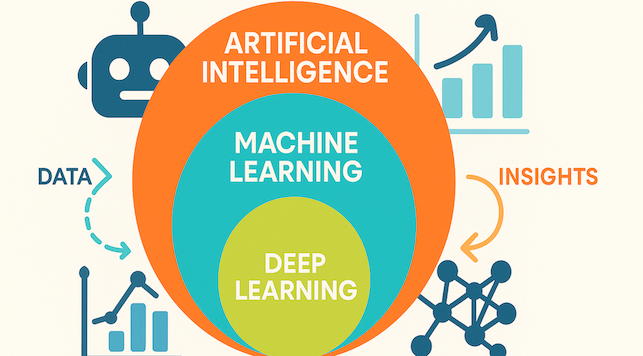I still remember a conversation with the head of operations at my latest company saying: “This isn’t good, it is machine learning not artificial intelligence”, obviously my head blew up immediately because, to me, these concept go hand-in-hand, especially in the mentioned case where AI was essentially a LLM. Although, after cooling down for some minutes I understood that maybe we are trapped in a sort of naming fad.
 A machine learning. Picture generated with gpt4o model.
A machine learning. Picture generated with gpt4o model.
At its heart, Artificial Intelligence is simply what it sounds like: the science and engineering of making intelligent machines that can reason, learn, and act autonomously [IBM]. The dream isn’t new. The field was officially born at the legendary Dartmouth Workshop in 1956, where pioneers like John McCarthy and Marvin Minsky first coined the term and laid out the audacious goal of making machines think [Wikipedia, Stanford].
For decades, the primary approach was what we now call Symbolic AI or “Good Old-Fashioned AI” (GOFAI) [AICorespot, Byteplus]. This early method relied on hand-coded rules and intricate logic. Imagine a chess program from the 1980s, meticulously programmed with every possible IF-THEN statement for every conceivable move. It could play a formidable game by following its rulebook, but it couldn’t learn from its opponent or discover a novel strategy on its own. It was intelligent, but brittle. Early expert systems designed to diagnose diseases worked the same way, using a vast decision tree of pre-programmed rules. The key takeaway is that AI is a vast field of study, not a single technology. It’s the overarching quest for machine intelligence in all its forms.
So, if that old, rule-based system is one way to build AI, how are we creating today’s incredible applications? That’s where Machine Learning comes in.
The Modern Engine: Machine Learning (ML) is the Pathway
If AI is the destination, Machine Learning is the superhighway we’re using to get there. ML is a subset of AI where systems learn patterns directly from data instead of being explicitly programmed with rules [MIT Sloan, IBM]. This marks a fundamental shift in approach. Instead of a programmer giving the machine a detailed rulebook, we provide vast amounts of data and let the machine figure out the rules for itself.
As Lifewire neatly puts it, “AI is the big idea, and machine learning is the engine that powers it” [Lifewire]. This engine is running all around you, every single day.
Consider these classic examples:
-
Spam filters: Your inbox stays clean because an ML model has learned to recognize the patterns, words, and structures common in junk mail by analyzing millions of emails you and others have marked as “spam.”
-
Netflix’s recommendation algorithm: It doesn’t follow a simple rule like “If user watches action movies, show more action movies.” It learns from the complex viewing habits of millions to suggest what you’ll likely want to watch next.
-
Credit card fraud detection: Banks use ML to learn your typical spending patterns. When a transaction appears that deviates wildly from that pattern, the system flags it as potential fraud—a task far too complex for simple IF-THEN rules.
The power of ML is so profound that it has become the dominant driver of progress in the field. It’s the workhorse doing the heavy lifting behind the scenes of modern AI.
The Hierarchy Explained: AI > ML > Deep Learning
To truly grasp the relationship, it helps to visualize it as a set of Russian nesting dolls.
 AI and ML belong to a set of nested concepts. Image generated with gpt4o model.
AI and ML belong to a set of nested concepts. Image generated with gpt4o model.
-
Artificial Intelligence (The Outer Circle): This is the entire universe of creating intelligent machines [IBM]. It includes everything from the old rule-based systems to the futuristic robots of science fiction.
-
Machine Learning (The Middle Circle): This is the most dominant and successful subfield of AI today [IBM]. Nearly every modern AI application you interact with is powered by ML.
-
Deep Learning (The Inner Circle): This is a specialized, and incredibly powerful, type of Machine Learning [Columbia AI]. It uses complex, multi-layered structures called neural networks, which are loosely inspired by the human brain. Deep Learning has revolutionized tasks involving unstructured data, like images, sound, and natural language. Applications like self-driving car vision, voice assistants like Siri and Alexa, and facial recognition software are all triumphs of Deep Learning.
As AI pioneer Andrew Ng has noted, “AI is the new electricity.” If that’s true, Deep Learning is the high-voltage power plant driving our most advanced systems.
What About Generative AI?
Machine learning and artificial neural networks have been out there for quite a long time now. What has happened to give rise this “AI” fuss explosion?. With tools like ChatGPT and Midjourney dominating headlines, you might be wondering where Generative AI fits in. Is it a new category altogether?
The answer is no. Generative AI is a cutting-edge application powered by very large Deep Learning models (like Large Language Models, or LLMs) [MIT News, Wikipedia]. Think of it not as a separate field, but as a spectacular new branch growing on the ML tree [MIT Sloan]. It’s the latest, most stunning proof of machine learning’s evolutionary power. As an MIT Sloan report highlights, generative AI showcases the incredible, and still expanding, potential of machine learning [MIT Sloan]. When ChatGPT generates human-like text or DALL-E creates a photorealistic image from a simple prompt, you are witnessing the direct result of decades of progress in ML and Deep Learning.
Why the Confusion? Media, Marketing, and a Bit of History
So, if the relationship is a clear hierarchy, why are the terms used so interchangeably? You’re not imagining the confusion; it’s fueled by a few key factors.
First, marketing. Let’s be honest, “AI” sounds more powerful, futuristic, and consumer-friendly than the more technical-sounding “Machine Learning.” It’s a catchier buzzword for a press release or a product launch.
Second, media simplification. Journalists often use “AI” as a shorthand to make complex topics more accessible to a broad audience, even when the underlying technology is purely ML.
Finally, there’s historical baggage. For decades, “AI” was the only term in the public consciousness. Now that almost all practical AI is ML-driven, the terms have become functionally interchangeable in casual conversation. As Google Cloud explains, “Most of the AI applications you hear about today are actually powered by machine learning” [Google Cloud]. The distinction is technically important, but in practice, the lines often blur.
Final note: Clarity for the Future
Understanding the landscape of artificial intelligence is no longer just for engineers. It’s essential for making smart decisions in a world increasingly shaped by these technologies.
The key takeaway is simple: AI is the quest, ML is the primary vehicle getting us there, and DL is its high-performance engine.
Knowing this difference empowers you. It helps executives make sound strategic investments, students choose their career paths, and developers design more effective systems. As machine learning continues to evolve, it will constantly redefine what’s possible within the broader dream of AI, leading to innovations we can only begin to imagine.
References:
-
AICorespot. “What is Non-Machine Learning AI?”
-
Byteplus. “Examples of AI which is not machine learning.”
-
Columbia AI. “Artificial Intelligence (AI) vs. Machine Learning.”
-
Google Cloud. “AI vs. Machine Learning: How Do They Differ?”
-
IBM. “What is Artificial Intelligence (AI)?”
-
IBM. “What Is Machine Learning (ML)?”
-
IBM. “AI vs. Machine Learning vs. Deep Learning vs. Neural Networks.”
-
Lifewire. “Artificial Intelligence vs. Machine Learning.”
-
MIT News. “Explained: Generative AI.”
-
MIT Sloan. “Machine learning, explained.”
-
MIT Sloan. “Machine learning and generative AI: What are they good for in 2025?”
-
Stanford. “The Dartmouth Workshop—as planned and as it happened.”
-
Wikipedia. “Dartmouth workshop.”
-
Wikipedia. “Generative artificial intelligence.”